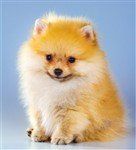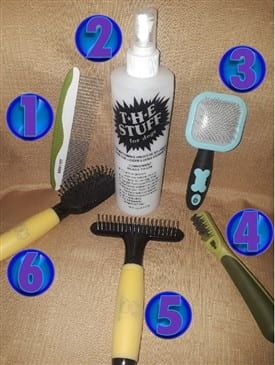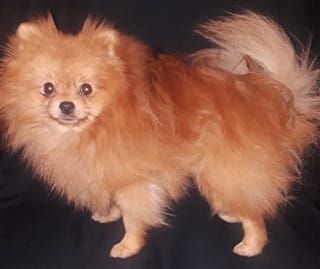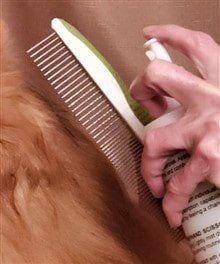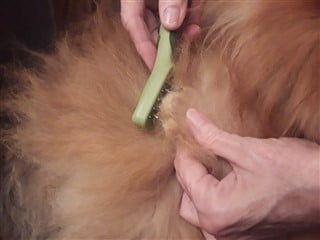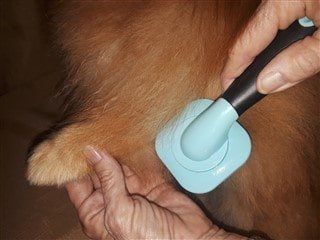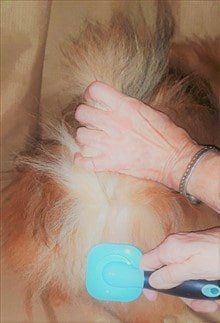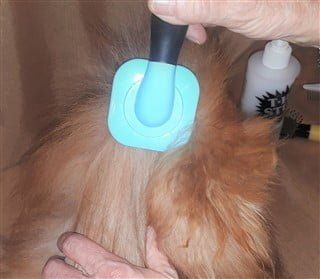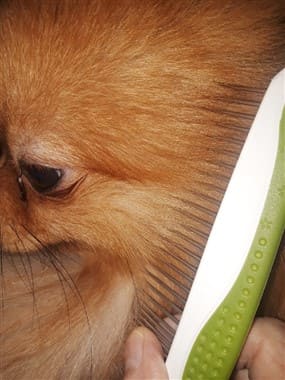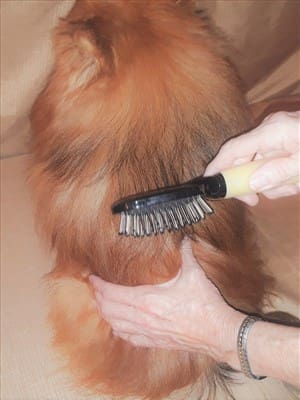How to Brush Pomeranian, withStep-by-Step Photos
First, a Quick Overview of a Pom’s Coat
If you’re not already familiar with the structure of a Pomeranian’s coat, this will help you understand why certain tools and steps are required when brushing.
Young pups
have a single coat of puppy fur. It’s super-soft and while it does slowly grow, it’ll never have a chance to become long since it all falls out within the first year. There is no shedding per se and hairs are too short to easily become tangled.
Older pups, starting around the 4 to 6-month mark, enter a phase known as the ‘puppy uglies’ in which puppy fur falls out and a new adult coat grows in (a term based on sometimes very patchy looking fur).
Adult Pomeranians, typically by the 12 to 15-month mark, have their double-coat of fur. There is an undercoat of very tightly-packed short fur. And there is an outer-layer comprised of longer guard hairs. The entire coat is very dense, there’s lots of shedding happening (even if you can’t see it) and hairs can easily become tangled. Brushing will help keep things under control.
Please note:
PetPom is reader-supported, and some of the product suggestions on this page are affiliate links. As an Amazon Associate we earn from qualifying purchases. This is at no extra cost to you and helps us continue providing free, high-quality information.
7 Things Brushing Will Accomplish
#1 Prevention and assessment of mats and tangles.
Though sometimes used interchangeably, tangles are knots in the hairs and mats are thick knots of weaved hairs close to the skin. These can form and grow quickly, be challenging to remove without snipping off fur, and can be painful as hairs are pulled in and pinch a dog’s skin. Routine brushing helps prevent these issues and is a good time to check the entire coat for any small ones.
#2 Body oil is distributed.
Natural body oil that seeps out of a dog’s skin pores can build up quickly. Brushing helps distribute the oil down through the coat. This helps dissipate the odor that can occur when it sits on a Pom’s skin and it helps keep fur nice and shiny.
#3 Shedded hairs are removed.
With Pomeranians, there is year-round shedding and (generally) two major seasonal sheds
of which the majority comes from the undercoat. Dead hairs that are not pulled out can block air circulation, become magnets for accumulated body oil (leading to a bad odor), and become twisted with live hairs which leads to mats.
#4 Improved health for skin and coat.
Brushing massages the skin for better blood flow and stimulates hair follicles for improved fur growth.
#5 Fine debris is removed.
Brushing helps remove tiny bits of food and other fine debris that’s picked up in the coat.
#6 Opportunity to apply protective leave-in spray.
Brushing is the perfect time to mist on a conditioning spritz. A good spray can keep fur properly moisturized, add shine, help prevent split ends and mats and repel urine 'splashback', contact allergens and irritants.
#7 A tidier, well-groomed Pom.
Of course, brushing your Pomeranian will also help keep your little guy or gal looking nice and neat.
How Often to Brush a Pomeranian
Puppies
up to the 12-month mark should be brushed 2 to 3 times a week to provide the benefits of distributing body oil, improved blood flow to the skin and stimulation of hair follicles, as well as allowing a pup to become accustomed to brushing sessions which will make life easier for you as the adult coat grows in and more intense brushing is required.
Ideally, adult Pomeranians
should be brushed every 2 days. This time frame usually works well to offer all 6 benefits as previously listed. If you use the right type of brushes, combs, and sprays, you cannot ‘over-brush’ a Pom, so even brushing your little guy or gal every day is just fine. Poms should also be combed and/or brushed before baths to check for tangles and separate the hairs in preparation for being shampooed.
Supplies to Have When Brushing a Pomeranian
The details of each supply can be found in our Pomeranian Grooming Tools article; however, here is a quick summary of what to have on hand to brush a Pomeranian.
1. A two-level steel comb.
One side has narrow teeth and the other has wide teeth. It should be made from quality stainless steel (never plastic) and appropriately sized. We recommend the Shiny Pet Stainless Steel Comb , as shown.
, as shown.
2. A leave-in conditioning/detangler spritz.
Opt for hypo-allergenic, properly pH-balanced, light spray that offers all of the benefits as previously listed but won’t weigh the coat down. One of our favorite leave-ins is The Stuff Leave-in Conditioner for Dogs , as shown.
, as shown.
3. A small bubble-tipped or polished-tip slicker brush.
Note that the type of tip is important so that it does not irritate a Pom's skin. Also, this will be your adult Pom’s main brush, so you want it to have a good grip and feel comfortable in your hand. One that we recommend is the Slicker Brush by PETPAWJOY , as shown.
, as shown.
4. A mat remover.
In case you come across a mat that you cannot removed, you’ll want to have one of these on hand. The blades need to be razor sharp so that it does not damage the coat and curved for safety reasons. We recommend the Safari Mat Remover , as shown.
, as shown.
5. A non-rotating undercoat rake.
This is for times of heavy shedding. Note that some undercoat rakes roll (or rotate) and those can severely strip and damage a Pom’s undercoat. So be sure to have a stationary rake tool. The tooth length is also vital as it must be able to reach all the way down through the undercoat. We recommend the Conair Pro Dog Undercoat Rake with Medium 3/4 Tooth , as shown.
, as shown.
6. A small bubble-tipped pin brush.
This is the main brush to use for a Pomeranian puppy (that still has their soft and short puppy coat). For an adult Pom, this is used as a ‘finishing brush’ to make final touches. We recommend the Conair PRO Small Pin Brush for Dogs , as shown.
, as shown.
How to Brush a Pomeranian: A Step-by-Step Guide
Now that you know why it’s important to brush a Pomeranian on a regular basis and you have all of your supplies, let’s dive in.
Meet Flame, a 1.5-year-old orange sable.
He’s going to be our model for these brushing instructions.
Step 1. First comb your Pom.
Pomeranians should be combed first before brushed, to check for mats and tangles and to prep the hairs.
Lightly spritz the comb with leave-in spray and very slowly go over each section of the coat. Lightly re-mist every 4 to 5 strokes.
Use the wide-tooth side for larger areas like the chest, back, and flanks. Use the narrow-tooth side for smaller areas like between the ears and the tops of the paws.
Step 2: If you find a mat or tangle, address it.
A tangle in the long guard hairs may be able to be worked out by hand. As soon as the comb gently snags on it, use your hands to pull out free hairs to isolate the tangle. Use a generous amount of leave-in spray (as long as you are using one that works as a detangler; otherwise, a 50/50 mix of your Pom's wash-out conditioner and water can work) on the knot itself and then use your fingers to slip hairs out and/or use the comb to pull hairs out.
A mat near the roots that’s imbedded in the undercoat is usually a bit trickier, however effort should be put into removing it by hand/comb.
If necessary, use the mat remover tool to remove just the isolated mat/knot.
Keep in mind that occasionally removing small pieces of tangled or matted fur this way will not have a huge effect on your Pom’s appearance. But it is a reason to assess things. A Pom may need to be brushed more often, sprayed more frequently with a leave-in conditioner, be exposed to less contact friction (a soft blanket can be placed down over comparatively coarse carpets), etc.
Step 3. Now it’s time to brush your Pom.
For Pom puppies
that do not yet have their adult coat, use the pin brush. For adult Pomeranians use the slicker brush at all times other than heavy shedding phases and use the rake tool when they are in the midst of a heavy shed.
For demonstration purposes, Flame is being brushed with the slicker brush.
Work in sections. It does not matter in which order you go, but be sure that other than the face, underbelly, and paws/ankles, that you do not skip any parts of the body. Commonly missed areas include the tail, under the tail, and the armpits.
As you brush, use a light mist of spray. Hold the bottle about 6 inches from your Pom and spray 1 to 2 inches from the roots. The brush will distribute it over the hair shafts. Be sure to go deep enough to brush through the undercoat and pull out dead hairs, but take obvious care with regard to proper pressure. Remove any accumulated fur from the brush as needed.
Step 4. Comb small areas.
Use the comb to carefully go over the face, the tops of the paws, and any other small areas in which you were not able to work through with the brush.
Puppies are now done. There is one final step for adult Pomeranians.
Step 5. Final touches.
For this, the pin brush is used. This will allow you to apply one final light mist of leave-in spray to protect the coat and brush through the hairs for nice texture and shine.
When spritzing, again, go very light. Hold the bottle about 6 inches from your Pom and spray 1 to 2 inches from the roots. Use the pin brush to glide from the roots to the tips.
Thank you, Flame, you were a great model!
Brushing photos courtesy of Dawn of WolfPack Poms.
Dawn is a highly respected AKC Pomeranian breeder who specializes in exotic colors including the very rare wolf sable (DNA tested). You can see read more about WolfPack Poms and see lots of adorable photos of her ladies, gents, and info on any available puppies here: Wolfpack Poms.
Related:
How to Remove Tear Stains on a Pomeranian
- The real reasons Poms develop tear stains and how to remove them for good. Includes step-by-step photos and before and after pics.
How to Help a Pomeranian Re-grow Their Fur
- Whether your Pom's groomer got carried away and shaved the coat or there was a health issue that caused fur loss, our guide will help restore the coat asap.

